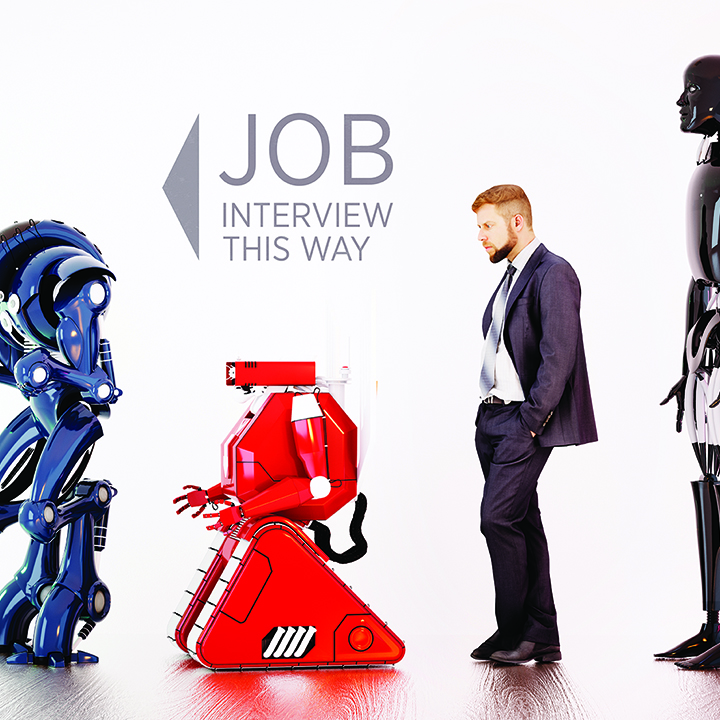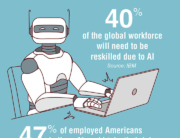The Fourth Industrial Revolution is upon us. Each of its predecessors had been powered by ground-breaking inventions: the development of mechanical production techniques harnessing water and steam power; electricity and mass production techniques; and advances in computing technology.
Driving this latest revolution is “cyber-physical systems” — computerbased algorithms, tightly integrated with the internet, deeply intertwined, and harnessing a range of exciting technological advances such as artificial intelligence, robotics, 3D printing, virtual/augmented reality, the Internet of Things, cloud computing, self-driving cars, predictive analytics, quantum computing, block chain and big data.
While Industrial Revolutions can be traumatic in their impact on individuals, more generally the result has been better-quality jobs and a better standard of living.
Of course, there’s no guarantee that we can rely on a similar outcome this time. The impending technological tsunami is unprecedented and, perhaps, more widespread in that it will hit the service sector and professional classes as much as unskilled workers.
In 2015, the World Economic Forum asked 800 technology experts what advances they expected to see by 2025. Their predictions: the first 3D-printed car, clothing that is connected to the internet and the first AI machine appointed to a corporate board of directors. Clearly, those surveyed were unaware that the last of their forecasts had already happened:Validating Investment Tool for Advancing Life Sciences, also known as VITAL, was appointed as a voting member of the board of Deep Knowledge Ventures, a venture capital fund, in 2014.
And outside the boardroom, robots have begun to perform a range of administrative tasks far removed from their more primitive forebears working on the production line. There’s Pepper, a Softbank product that can perform a number of functions such as hotel concierge, car salesman, estate agent, data collector, thespian or promotions assistant; Leo, a baggage handler at Zurich Airport; Ademco, a robotic security guard; and Mitsubishi’s Wakamaru, which has presented at exhibitions, guided customers, and worked as a receptionist since 2005.
Staffing Revolution 4.0
Such advances will undoubtedly have a huge effect on the staffing industry. Many jobs will be replaced or profoundly changed, and many new jobs will appear. Beyond this, staffing firms will need to consider the way their services will be delivered, determining what should be automated and what shouldn’t. The staffing firm of the future likely will offer both human and nonhuman solutions to help clients get work done. Innovative providers have sprung up like Robots of London, where you can buy or hire a robot to perform work tasks in much the same way you’d buy (perm) or hire (temp) a human worker from a staffing firm. The mixed ‘man-machine’ staffing model has been embraced by Dutch staffing firm HOBIJ, which offers its clients in the food, technical, industrial or logistics sectors a choice of human or robotic labour, while Silicon Valley’s Knightscope adopts a ‘software + hardware + humans’ approach in the provision of autonomous robots for security assignments. It’s unlikely that the larger international staffing firms will get left behind in this respect; Recruit, the Japanese staffing giant, has established an Institute of Technology in Silicon Valley to study artificial intelligence.
Automation is hardly new to the staffing industry, but its versatility and sophistication has now reached a level where staffing executives need to determine whether internal tasks are best performed by brain power or machine power. While no one expects the staffing industry to be completely automated, there are activities where the effectiveness and cost of machine power is becoming compelling.
Staffing executives should consider:
Is the work best conducted remotely or in person? If there are parts of your services that don’t depend on face-to-face communication, do you really need a ‘face’ to represent your business at all? One of the most important developments in the recruitment space over the past 12 months has been the emergence of recruitment chatbots to support initial candidate engagement. Numerous products have sprung up: Mya, Job Pal, Karen, Talla, Stanley and Xor while, in 2016, Randstad invested in Wade & Wendy.
Can you rely on an algorithm or do you need intuition? While intuition is, quite rightly, a highly valued quality of a successful recruitment consultant, human beings are also saddled with biases and prejudices that don’t necessarily result in the best outcome for your business. An algorithm, on the other hand, is stable, predictable and operates 24/7. Companies such as CitySail provide digitised interviews that can be utilised for sophisticated ‘micro-expression’ analysis in order to determine mood and personality matching.
Are you selling a transaction or a consultation? There are many unskilled roles that are quite transactional in nature while others require a deeper understanding of the hiring company, its culture and strategy and are more advisory in nature. We have already started to see human intermediaries extracted from some of these transactional roles with the growth of so-called ‘just-intime’ staffing firms, the most successful example of which is Swiss firm, Coople.
Of course, in many respects, the right solution to these questions isn’t to opt for man (or woman) over machine or vice versa but to consider the advantages of harnessing machine power to empower your employees and provide a betterquality service to your clients.
Staffing firms can also look forward to enhancements in the recruitment technology they use. Every software manufacturer is currently considering how artificial intelligence can be used to upgrade their products (if they haven’t made such upgrades already). Cognitive systems with self-learning capability have the potential to take searching, screening and matching tools to a whole new level and staffing executives can look forward to more intelligent software to support their processes. Google for Jobs is the most recent example of the use of machine learning to enhance the job search process. As these products evolve, however, it becomes as much a minefield as it is an opportunity — picking the right cutting-edge product in such a fast-moving and volatile market will not get any easier.
We’re also on the cusp of a revolution in data analytics and many companies operating in the workforce solutions ecosystem are investing significant amounts of time and money in developing their capability in this respect. We are beginning to see the emergence of more insightful and more predictive analytics enhanced by machine learning, particularly from job boards, MSPs, VMSs and ATSs as part of the big data wave, such as Brightfield Strategies’ Talent Data Exchange and SAP Fiedglass’s Live Insights.
A new legislative landscape. One challenge caused by anything that affects society on a large scale is that legislation will need to evolve — and the growth of robotics and artificial intelligence certainly will require that. Expect some dramatic changes in employment and other laws. Areas that would likely see significant change due to this fourth revolution:
• Data protection. This is already a hot topic, with more rigorous protections being afforded to individuals in many jurisdictions alongside increasingly harsh criminal sanctions and costly civil penalties for organizations that fail to abide by the law. The fact that emerging technologies will be able to do so much more with personal data suggests that this focus on data protection is not going away any time soon. Governments will continue to seek to protect the privacy of individuals and provide them with legal opt-outs from profiling.
• Treatment of redundancy through digitization. Where jobs are lost as a direct result of automation, governments may seek to ameliorate the effects by providing an automatic right to re-training for displaced workers or other career support initiatives, especially in continental Europe where the social model is more prevalent.
• Human worker quotas and/or tax incentives to retain human workers. Organizations could be incentivized to maintain employment levels through tax breaks or even the imposition of quotas.
• Union-led collective agreements on machine-man interaction. As employees interact with technology more regularly, it seems likely that unions will want to exercise their influence over worker rights as they relate to the use of artificial intelligence and robotics, especially when such technology takes on a supervisory role.
• Allocation of ‘e-person’ liability. The first death caused by a robot was when a Ford Motor assembly line worker was killed in Michigan in 1979. When robots go wrong, there will need to be clarity over roles and responsibilities in determining the degree of culpability among the individual programmer, the corporation providing the robot, the corporation using the robot and the robot operator.
• Universal basic income. Universal basic income is now being considered as a potential solution to the problems of a society facing fewer jobs and lower wages. State provision of a universal basic income of just under £4,000 a year wouldn’t be enough to take someone out of poverty, but it could give them the flexibility to work part-time, provide access to retraining opportunities or breathing space to find a worthwhile job without facing benefit sanctions. With trials underway in the Netherlands, Italy, Finland and UK, enthusiasts for the idea include Elon Musk, former Clinton labour secretary Robert Reich, French socialist Benoît Hamon, and South Korean presidential candidate Lee Jae-myung.
So where does all this leave the busy staffing executive? Like usual, facing an uncertain future and a period of profound change. Such uncertainty shouldn’t necessarily be perceived as a negative; after all, if business was completely predictable, organisations would not need to use temporary labour in the first place. For those who bother to stay informed about the impact of artificial intelligence and robotics, the Fourth Industrial Revolution could turn out to be a huge opportunity.







